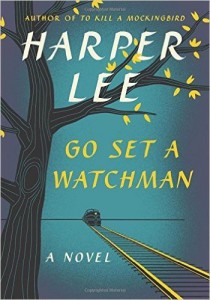The Blog
 Go Set a Watchman by Harper Lee is a novel of ideas, not action. Unlike Lee’s famous novel To Kill a Mockingbird, Go Set a Watchman moves slowly, and what little action there is appears often unrelated to the themes of the novel. But once Lee reaches the point where she can launch into the ideas that obviously drove her to write Go Set a Watchman, the novel takes off.
Go Set a Watchman by Harper Lee is a novel of ideas, not action. Unlike Lee’s famous novel To Kill a Mockingbird, Go Set a Watchman moves slowly, and what little action there is appears often unrelated to the themes of the novel. But once Lee reaches the point where she can launch into the ideas that obviously drove her to write Go Set a Watchman, the novel takes off.
For the first 100 pages, Go Set a Watchman wanders with its protagonist, Jean Louise Finch, from New York City down to her hometown, Maycomb, Alabama, and through her antics with her boyfriend, Henry, when she arrives there. Lee gives detailed descriptions of Maycomb, the people who live there, and especially the Finch family, including flashbacks to Jean Louise’s childhood with her father, Atticus, and her brother, Jem. Although these scenes are appealing, they don’t have the edge or the force of the early scenes in To Kill a Mockingbird, mainly because they aren’t relevant to the rest of the book in the way the children’s involvement with Boo Radley in To Kill a Mockingbird is.
When Jean Louise discovers a pamphlet entitled The Black Plague among her father’s papers, her Aunt Alexandra explains the pamphlet came from the Maycomb County Citizens’ Council, of which Atticus and Henry are both members. The council happens to be meeting at the courthouse that afternoon, so Jean Louise climbs to the courthouse balcony and watches the proceedings just as she watches the trial in To Kill a Mockingbird. She is horrified by what she sees. The purpose of the group is to resist integrating black and white children in the public schools as required by the recent Supreme Court decision, Brown v. Board of Education.
The shock to Jean Louise is that her father, whom she has always respected and loved as a pillar of fairness and integrity, could be part of such a group. Her love for him has always been the most potent moral force in her life. Before she made any important decision, she always considered, “What would Atticus do?” And now she finds him on the wrong side of an issue. “What was this blight that had come down over the people she loved?” Here is where Go Set a Watchman’s fire begins.
Jean Louise is no shy child and she goes after Atticus, Henry, and her uncle Jack to chastise them in no uncertain terms. She is ready to leave Maycomb and go back to New York, but first she has to say her piece. In all of these discussions, Lee lays out arguments, counter-arguments, historical influences, and explanations. She looks at the moral aspects of the issue and the legal.
Jean Louise admits to her father that when she first heard about the Supreme Court decision, she was angry. It seemed to her that by upholding the equal protection clause of the 14th amendment to the Constitution, the Court was erasing the 10th amendment, which defines the separation of powers between the federal government and the states. In other words, the Supreme Court has no right to tell the states how to run their schools.
But, even though Jean Louise thinks the method is wrong, she knows that segregation has to be ended and can’t understand why her father doesn’t believe that. She’s also astounded when her Uncle Jack tells her she’s a bigot—until she looks up the true meaning of the word.
I can’t help but think that Go Set a Watchman is at least partially autobiographical, in the way that many first novels are. After studying law at the University of Alabama in the late 1940s, Lee went to New York to pursue a literary career. I can imagine her reaction to ideas she encountered on her visits home during the 1950s. Her surprise and disappointment would cause her lawyer’s mind to explore the how’s and why’s of those ideas. And then she had to write about them.
Go Set a Watchman is an interesting and provocative discussion of an issue, but, unfortunately, not a very good story. I’ve read that the publisher Lee submitted the novel to in the 1950’s rejected it, and I understand why. Go Set a Watchman lacks the blending of ideas and actions and the interwoven plot lines that characterize To Kill a Mockingbird. But I believe Lee had to write Watchman first to get her anger out in its most white-hot form before she could tame it to create a more subtle work of art.
Without Go Set a Watchmen, To Kill a Mockingbird might never have been written.
Tags: Books, Go Set a Watchman, Harper Lee, novels, reviews, Southern Writers
Get in Touch
Follow on Facebook
Follow on Twitter
___________________________________________________
Website Design by Eliza Whitney
 Posts from Late Last Night Books
Posts from Late Last Night Books



